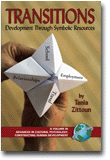
Transitions
Symbolic Resources in Development
By:
Tania Zittoun, University of Neuchâtel (Switzerland)
A volume in the series: Advances in Cultural Psychology: Constructing Human Development. Editor(s): Jaan Valsiner, Niels Bohr Professor of Cultural Psychology, Aalborg University.
Published 2006
What do young people do with the novels they read, the films they see, the music they hear and sing? How do these cultural products act as ‘symbolic resources’ in the process of development? And what can we, as researchers, learn by studying people’s uses of fiction? This monograph approaches development through the study of transitions and the processes of exploration that follow ruptures in people’s lives. Specifically, it examines young people’s symbolic responsibility as they have to choose among the wide range of cultural products societies exposes them to. The book thus examines the books, films and music that young people mobilize when they need to redefine their identity, learn informal know-how, or have to confer meaning to what happens to them in transitions. The book has a theoretical scope. It draws on cultural psychology and psychoanalysis to formulate the importance of semiotic mediation in thinking, feeling and acting. Its main contribution is to propose a model for analyzing uses of symbolic resources, such as books and films, in everyday life. It thus shows how uses of symbolic resources can enable new forms of experiences and conduct. It finally highlights social and personal conditions that might facilitate or hinder developmental uses of symbolic resources. The book, based on in-depth case studies, is addressed to scholars, professional and students in the fields of youth, culture and the media, cultural and developmental psychology, and life-long education.
CONTENTS
Chapter I: Young adults in blurred fields of changing media. Chapter II: Modeling cultural experiences and symbolic resources in development. Chapter III: Accessing personal cultures. Chapter IV: Young people’s uses of symbolic resources. Chapter V: Cultural “bricolage” in transitions. Chapter VI: Youth transitions, symbolic processes and the lifespan.
-
Paperback978-1-59311-226-4
Web price: $45.04 (Reg. 52.99)
-
Hardcover978-1-59311-227-1
Web price: $80.74 (Reg. 94.99)
- eBook9781607525028

- FAM003000 - FAMILY & RELATIONSHIPS: LIFE STAGES: Adolescence
- EDU009000 - EDUCATION: Educational Psychology
- EDU015000 - EDUCATION: Higher
-
 Culture, Work and Psychology
Invitations to Dialogue
Culture, Work and Psychology
Invitations to Dialogue
-
 Deep Loyalties
Values in Military Lives
Deep Loyalties
Values in Military Lives
-
 Drama of Multilingualism
Literature Review and Liberation
Drama of Multilingualism
Literature Review and Liberation
-
 From Dream to Action
Imagination and (Im)Possible Futures
From Dream to Action
Imagination and (Im)Possible Futures
-
 Home in Transition
The Cultural Construction of Heimat
Home in Transition
The Cultural Construction of Heimat
-
 Making of Distinctions
Towards a Social Science of Inclusive Oppositions
Making of Distinctions
Towards a Social Science of Inclusive Oppositions
-
 Ornamented Lives
Ornamented Lives

